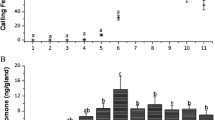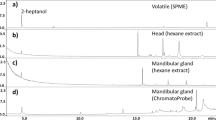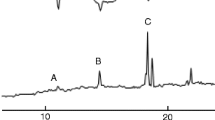Abstract
The response of an antennal receptor cell of the turnip moth,Agrotis segetum, was recorded during stimulation with a series of (Z)-7-dodecenyl acetate analogs with structural variations of the acetate group. The investigated receptor cell is known to be highly selective to (Z)-7-dodecenyl acetate. All parts of the acetate group were found to be of great importance for full biological activity. The results indicate very strict requirements on the shape of the polar functional group, as well as on its electron distribution for a successful interaction with the antennal receptor cell.
Similar content being viewed by others
References
Allen, F.H., Bellard, S., Brice, M.D., Cartwright, B.A., Doubleway, A., Higgs, H., Hummelink, T., Hummelink-Peters, B.G., Kennard, D., Motherwell, W.D.S., Rodgers, J.R., andWatson, D.G. 1979. The Cambridge Crystallographic Data Centre: Computer-Based Search, Retrieval, Analysis and Display of Information.Acta Cryst. B35:2331–2339.
Allinger, N.L., andYuh, Y.H. 1980. Quantum Chemistry Program Exchange 11, Program No. 395.
Bestmann, H.J., andVostrowsky, O. 1982. Structure-activity relationships in insect pheromones. A dynamical model of pheromone interactions with receptor sites, pp. 253–263,in W. Breipohl (ed.). Olfaction and Endocrine Regulations. IRL Press, London.
Boeckh, J., Kaissling, K.-E., andSchneider, D. 1965. Insect olfactory receptors.Cold Spring Harbor Symp. Quant. Biol. 30:263–280.
Burkert, U., andAllinger, N.L. 1982. Molecular Mechanics. American Chemical Society, Washington, D.C.
Cardé, R.T., andRoelofs, W.L. 1977. Attraction of redbanded leafroller moths,Argyrotaenia velutinana, to blends of (Z)- and (E)-ll-tridecenyl acetates.J. Chem. Ecol. 3:143–152.
Curl, R.F., Jr. 1959. Microwave spectrum, barrier to internal rotation, and structure of methyl formate.J. Chem. Phys. 30:1529–1536.
Dodd, G.H. 1976. Structure-activity relationships in chemoreception. A preview, pp. 1–9,in G. Benz (ed.). Structure-Activity Relationships in Chemoreception. Information Retrieval, London.
Hallberg, E. 1981. Fine-structural characteristics of the antennal sensilla ofAgrotis segetum (Insecta: Lepidoptera).Cell Tissue Res. 218:209–218.
Hayashi, M., andKuwada, K. 1975. Microwave spectrum, structure, dipole moment and internal rotation oftrans-ethylmethylether.J. Mol. Struct. 28:147–161.
Houx, N.W.H., Voerman, S., andJungen, W.M.F. 1974. Purification and analysis of synthetic insect sex attractants by liquid chromatography on a silver-loaded resin.J. Chromatogr. 96:25–32.
Kafka, W.A., andNeuwirth, J. 1975. A model of pheromone molecule-acceptor interaction.Z. Naturforsch. 30c:278–282.
Kaissling, K.-E. 1971. Insect olfaction, pp. 351–431,in L. Jaenicke (ed.). Handbook of Sensory Physiology, IV. Chemical Senses, 1. Olfaction. Springer Verlag, Berlin.
Kaissling, K.-E. 1974. Sensory transduction in insect olfactory receptors, pp. 243–273,in L. Jaenicke (ed.). Biochemistry of Sensory Functions. Springer Verlag, Berlin.
Kaissling, K.-E. 1976. The problem of specificity of olfactory cells, pp. 137–144,in G. Benz (ed.). Structure-Activity Relationships in Chemoreception. Information Retrieval, London.
Kaissling, K.-E. 1977. Structure of odour molecules and multiple activities of receptor cells, pp. 9–16,in J. Le Magnen and P. Mac Leod (eds.). Olfaction and Taste VI. Information Retrieval, London.
Lehmann, F.P.A. 1978. Stereoselective molecular recognition in biology, pp. 3–77,in P. Cuatrecasas and M.F. Greaves (eds.). Receptors and Recognition, Series A. Chapman and Hall, London.
Löfstedt, C., Van Der Pers, J.N.C., Löfquist, J., Lanne, B.S., Appelgren, M., Bergström, G., andThelin, B. 1982. Sex pheromone components of the turnip moth,Agrotis segetum: Chemical identification, electrophysiological evaluation and behavioral activity.J. Chem. Ecol. 8:1305–1321.
Pierce, L., Chang, K., Hayashi, M., andNelson, R. 1969. Microwave spectrum, dipole moment, and internal rotation oftrans-2-butanone.J. Mol. Spectrosc. 32:449–457.
Pople, J.A., andBeveridge, D.L. 1970. Approximate Molecular Orbital Theory. McGraw-Hill, New York.
Priesner, E. 1979. Specificity studies on pheromone receptors in noctuid and tortricid Lepidoptera, pp. 57–71,in F.J. Ritter (ed.). Chemical Ecology: Odour Communications in Animals. Elsevier/North Holland, Amsterdam.
Priesner, E. 1980. Sensory encoding of pheromone signals and related stimuli in male moths, pp. 359–366,in Insect Neurobiology and Insecticide Action (Neurotox 79). Society Chem. Ind., London.
Roelofs, W.L., andComeau, A. 1971. Sex pheromone perception: Synergists and inhibitors for the red-banded leafroller attractant.J. Insect Physiol. 17:435–448.
Schneider, D. 1957. Eletrophysiologische Untersuchungen von Chemo- und Mechanorezeptoren der Antenne des SeidenspinnersBombyx mori L.Z. Vergl. Physiol. 40:8–41.
Schneider, D., andSteinbrecht, R. A. 1968. Checklist of insect olfactory sensilla.Symp. Zool. Soc. London 23:279–297.
Steck, W., Underhill, E.W., andChisholm, M.D. 1982. Structure-activity relationships in sex attractants for North American Noctuid moths.J. Chem. Ecol. 8:731–754.
Struble, D.L. 1981. A four-component pheromone blend for optimum attraction of redbacked cutworm males,Euxoa ochrogaster (Gueneé).J. Chem. Ecol. 7:615–625.
Tumlinson, J.H. 1979. The need for biological information in developing strategies for applying semiochemicals, pp. 301–311,in F.J. Ritter (ed.). Chemical Ecology: Odour Communication in Animals. Elsevier/North Holland, Amsterdam.
Van Der Pers, J.N.C. 1982. Comparison of single cell responses of antennal sensilla trichodea to sex attractants in nine European small ermine moths (Yponomeuta spp.)Entomol. Exp. Appl. 31:255–264.
Van Der Pers, J.N.C., andLöfstedt, C. 1983. Continuous single sensillum recording as a detection method for moth pheromone components in the effluent of a gas chromatograph.Physiol. Entomol. 8:203–211.
Van Der Pers, J.N.C., andDen Otter, C.J. 1978. Single cell responses from olfactory receptors of small ermine moths (Lepidoptera: Yponomeutidae) to sex attractants.J. Insect Physiol 24:337–343.
Author information
Authors and Affiliations
Rights and permissions
About this article
Cite this article
Liljefors, T., Thelin, B. & Van Der Pers, J.N.C. Structure-activity relationships between stimulus molecule and response of a pheromone receptor cell in turnip moth,Agrotis segetum . J Chem Ecol 10, 1661–1675 (1984). https://doi.org/10.1007/BF00987353
Received:
Revised:
Issue Date:
DOI: https://doi.org/10.1007/BF00987353




